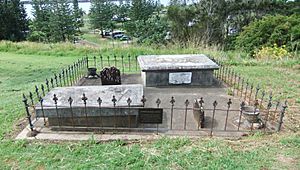Port Macquarie First Burying Ground facts for kids
Quick facts for kids Port Macquarie First Burying Ground |
|
|---|---|

Surviving gravestones in 2011
|
|
| Location | Clarence Street, Port Macquarie, Port Macquarie-Hastings Council, New South Wales, Australia |
| Built | 1822–1824 |
| Owner | Port Macquarie-Hastings Council |
| Official name: Port Macquarie First (Allman Hill) Burying Ground 1822 - 1824; Allman Hill Burying Ground; Port Macquarie Burying Ground; Old Port Macquarie Cemetery | |
| Type | state heritage (landscape) |
| Designated | 1 July 2005 |
| Reference no. | 1730 |
| Type | Cemetery/Graveyard/Burial Ground |
| Category | Cemeteries and Burial Sites |
| Lua error in Module:Location_map at line 420: attempt to index field 'wikibase' (a nil value). | |
The Port Macquarie First Burying Ground is a very old cemetery in Port Macquarie, New South Wales, Australia. It's now a public park where people can visit. This special place is also known as Allman Hill Burying Ground or Old Port Macquarie Cemetery. It was used from 1822 to 1824 and is owned by the Port Macquarie-Hastings Council. It was added to the New South Wales State Heritage Register on July 1, 2005, because of its important history.
Contents
History of the Burying Ground
In the early 1800s, Port Macquarie was a "penal settlement." This means it was a place where convicts (people who had committed crimes) were sent from Britain. The people in charge knew they would need a place to bury those who died.
Choosing the Location
The chosen spot was on a hillside. It was a good choice because it had good drainage and was easy to dig. It was also a bit away from the main settlement area.
First and Last Burials
The very first person buried here was a convict named James McMahon on July 22, 1822. The last of 28 people buried here was another convict, John Abrahams, on November 14, 1824. By this time, the settlement needed a new burial ground further away. So, the Second Burying Ground was started.
What the Burying Ground Looks Like Today
The Allman Hill Burying Ground is on a grassy hill that looks out over the Hastings River. It's a nice spot with views of the water.
Remaining Monuments
Most of the 28 burial spots don't have any markers left. However, there are four old monuments (gravestones) that you can still see. They are inside a small fenced area. These monuments are very old and show how people remembered the dead back in the convict era.
A Public Park
Over the years, this old cemetery was changed into a public park. Even though it's now a park, it's still managed as an important historic site. The area where people were buried might have been much larger than the small fenced part we see today. The site is also important for archaeologists (people who study the past by digging up old things) because it could still hold clues about early New South Wales history.
Why This Place is Important
The Allman Hill Burying Ground is very important to the history and culture of New South Wales. It's listed on the State Heritage Register for many reasons:
Historical Importance
This site tells us a lot about the early days of Port Macquarie and New South Wales. It's the burial place for at least 28 people who lived and worked in this important early settlement. It helps us understand the lives of people from that time, including convicts and early settlers.
Community Connection
The burying ground has a strong connection with the people of Port Macquarie, both in the past and today. Many people in the community care deeply about this site and want to protect it. Tourists also visit it often.
Educational Value
This site is a great place to learn! It can help us understand:
- How people lived in early New South Wales.
- The history of architecture and design of monuments.
- How families and communities developed.
- Genealogy (studying family histories).
Rare and Unique
Because it started so early (in 1821), even before official records of births, deaths, and marriages began in New South Wales, this burying ground is quite rare. Each cemetery is unique because it holds the remains of different people, and this one shows us a rare example of an early convict-era burial ground.

